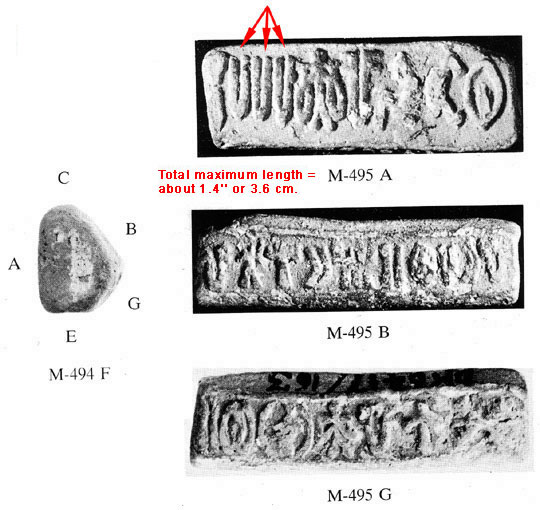Claims Concerning the Longest Indus ‘Inscription’
The longest Indus ‘inscription’ (if that’s the right word) on a single flat surface is M-314, which contains 17 non-repeating symbols. Like all but one Indus ‘inscription’, it is tiny – just how tiny is clear when we compare M-314 with a proto-Elamite inscription.
Indus-script adherents sometimes claim (usually quickly, and without much discussion) that the longest Indus ‘inscription’ is 26 signs long. The claim refers to two isolated examples of a mass-produced molded object (M-494 and M-495) on which, if you add up all the symbols on three separate faces of the five long surfaces (there are seven surfaces if you include the sides), does give you 26 symbols. The symbol sequences carried on the three sides are the sort you would expect to find on separate chains of Indus symbols on other objects of this type – which is presumably one reason this claim is made so quickly.
For the best available photographs of these badly worn objects, see the representations of M-495 provided below from Vol. 1 of the Corpus of Indus Seals and Inscriptions. A side shot of M-494 (not available for M-495) is also included to get a better perspective of what the original objects – which are again surprisingly tiny – looked like.
The thesis that the symbols provide a continuous ‘message’ has never been defended in print or backed by any evidence – and the claim that the symbols are ‘writing’ is even weaker. A great deal of evidence suggests that mass-produced molded inscriptions (to my mind, the most unique objects bearing Indus signs – absolutely nothing like these mass-produced objects exist in the Near East) were used in Indus communal rituals, and carried religious and sacrificial symbols, not ‘writing’ as linguists normally use that term.
For one obvious piece of evidence for this thesis even this case, see the three repeating symbols on one of the faces, which I’ve marked with red arrows – which can be convincingly shown from other evidence to represent a sacrifical bowl (acknowledged as such even by Parpola 1994: 109, but not in reference to this inscription).
It should be finally noted that chains of non-linguistic symbols often much longer than this are found in other non-linguistic sign systems, e.g., in long chains of divinity symbols seen on Near Eastern kudurru stones. See, e.g., the brief discussion of systems of this type in “The Collapse of the Indus-Script Thesis“, pp. 38-42.
The actual size of this piece is again much smaller than it appears here or in the Corpus: It is given by Marshall 1931 (Vol. II, p. 402) as 1.4 inches = 3.6 cm in size (but Marshall’s photos in Vol. III, Plate CXVI, #23, which are supposedly to scale, make it appear even smaller than that).

Feb 2023 format changes from web server migration.
